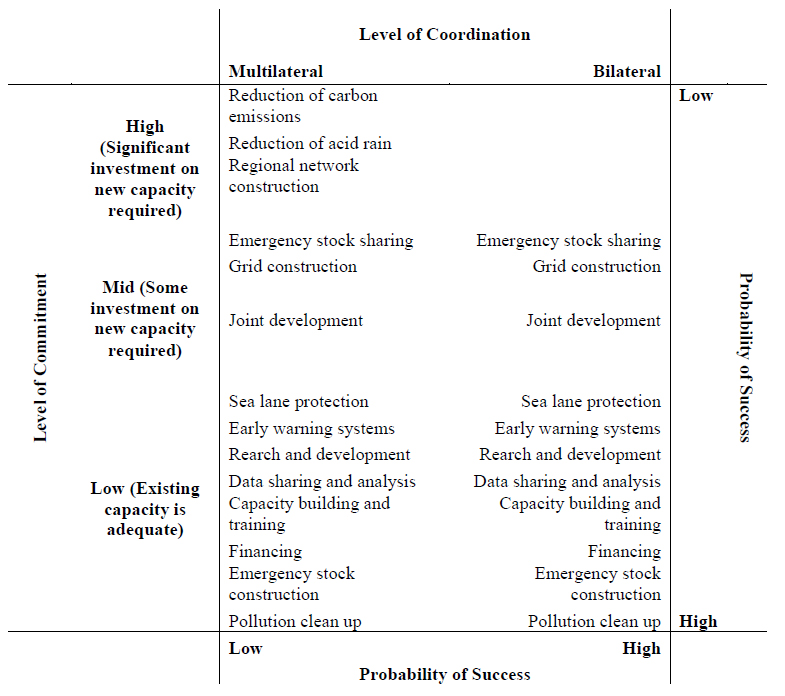Towards a Framework for Energy Cooperation in Northeast Asia: Challenges and Opportunities1
Northeast Asia is home to some of the largest and fastest-growing economies in the world. The World Bank estimates that the three largest players in the region—China, Japan, and South Korea—account for approximately 40 percent of global GDP growth. The combined average real per capita GDP of these three countries is about $70,000 after accounting for purchasing power. Inhabited by approximately 1.5 billion people with an average vehicles per capita ratio of about 0.25 (1 car for every 4 people), the hunger for energy has never been greater. The IEA estimates that China, Japan, and South Korea make up about one third of global energy consumption today and the demand for energy in the region is only expected to grow in the foreseeable future.2
Needless to say, continued flow of safe, secure, and affordable energy supply is a high priority in the region. While China maintains a rich endowment of coal and natural gas, Japan and South Korea have a wealth of experience in nuclear power. Much of the energy (i.e. oil) consumed in the region is imported. Although China is the largest coal producing country in the world, it is also the largest net importer. There has been an across-the-board suspension of nuclear power generation in Japan in the aftermath of the Fukushima disaster while South Korea’s spent fuel storage capacity will reach its limit by 2016 without any interim measures being adopted. Alternative energy is hardly a factor in South Korea’s energy portfolio while it has taken up a significant portion of the mix in China and Japan. What all of this suggests is that the three countries face different challenges with respect to energy security; however, they stand to benefit from a regional cooperation scheme if such framework can be realized.
The purpose of this brief is to suggest an approach for managing the issue of energy security through a cooperative framework. The goal is less to provide concrete answers than to suggest a way forward in addressing the problem of energy security at the regional level.
What are the underlying reasons for challenges to regional energy security?
1. Geographic challenges
While the three countries are relatively close to one another, they are separated by the East Sea, the East China Sea, and the Yellow Sea. The Korean Peninsula is part of continental Asia, but transport by land between China and South Korea is not possible given that the two Koreas have maintained a state of war over the past six decades.3 In short, infrastructure connections lag capacity needs. What this means is that transportation of oil or gas in the region will require reliance on relatively distant and costly methods of transport.
2. Geopolitical risks
There is little denying the uneasy relations between Japan and South Korea as well as Japan and China. Prime Minister Abe’s openness about his visits to the controversial Yasukuni Shrine, as well as revision of the Constitution to enable Japan to potentially forward deploy its military, have reopened old wounds from World War II. Maritime disputes in the East China Sea (i.e. Senkaku/Diaoyu, Air Defense Identification Zone—ADIZ), East Sea (or the Sea of Japan) (i.e. Dokdo/Takeshima), the Yellow Sea (i.e. Northern Limit Line), also make for potentially explosive and serious security risks. China and Japan are fundamentally engaged in a long-term rivalry for regional power and dominance. While South Korea maintains good diplomatic and trade relations with China, there is no hiding the fact that South Korea has a long-standing robust alliance built on prolonged US military presence on the peninsula since the ceasefire. The threat to the peace and stability of the region is further compounded by an opaque dictatorial regime in North Korea that has openly professed its intent to develop its own domestic nuclear weapons program despite opposition from the international community.
3. Heterogeneous energy policy and energy sectors
The energy portfolio and challenges to energy security vary among the three countries. For instance, Japan does not maintain any gas grid; hence, pipeline gas from mainland China or even Russia may matter less for Japan than it does for South Korea, which maintains a rather well developed gas grid. It is also important to realize that up to 300 million people in Asia do not have access to electricity. Having a reliable and well-connected electricity grid will continue to be an important challenge in the region. South Korea and China look to expand their nuclear capacity with new plant constructions; however, safety remains an important concern, as illustrated by Japan’s uncertainty over its reliance on nuclear power following the Fukushima disaster.4 There is room for cooperation in the area of nuclear safety but there is also some difficulty in the fact that the three countries utilize different technologies in running their nuclear power plants.
4. Financing
Regional capital and the finance market are not mature enough. Meanwhile, investment needs are large because project size tends to be large when considering energy projects in this region. Pooled investments and/or joint public-private investment will be required.
5. Lack of a coordinating mechanism
There is no overarching mechanism or framework such as the International Energy Agency (IEA) that can address some of the challenges associated with risks to energy security across countries within this region. Energy is a highly technical issue that requires continual dialogue, information sharing, and coordination. Without an institutional vehicle for addressing the risks to energy security from unexpected disruption in supply or emergency disasters, preventative measures (e.g. stockpile reserves or best practice safety protocol) or even positive gains through technology transfer and/or financing would be difficult.
Is there a better way forward in achieving a more stable, safe, and affordable energy supply? If so, what would this require?
One way to mitigate the risks and challenges to a more reliable, safe, and affordable energy supply is to enhance cooperation within the region. There is broad consensus that institutions play a critical role in promoting international and/or even regional cooperation. While existing research suggests that broad and deep multilateral approaches are preferable to restricted and narrow bilateral efforts, we estimate that the marginal gains from even small-scale bilateral cooperation would prove significant enough as to warrant cooperation at a more local level. Table 1 prioritizes some possible concrete measures that one may take in overcoming challenges to regional energy security according to the level of commitment and the level of coordination. By the level of commitment, we are referring to the amount of investment required in attaining the required capacity to achieve the desired outcome. And by the level of coordination, we are referring to the extent of coordination (i.e. multilateral vs. bilateral). We assume that the probability of success is inversely proportional to the level of commitment and investment.
Table 1: Approaches to Regional Cooperation on Energy5
The lower right quadrant where each country maintains relatively strong capacity but requires more localized bilateral coordination, such as research and development or data sharing and analysis, can be implemented rather easily. Of course, these tasks can also be handled multilaterally but collective action tends to be more difficult with the rise in the number of coordinating stakeholders. Environmental concerns, such as carbon emissions or acid rain, are difficult problems that necessarily require significant investment and broad-based participation. Hence, the nature of the policy problem lends itself to multilateralism and more significant investment in capacity building. While problems like these are important to the region because of their nature and impact, they are more difficult to achieve because of the challenges associated with their implementation. In short, cooperation on energy can be prioritized and targeted according to the needs of each country, but it can also be organized according to the likelihood of implementation. The framework is useful to the extent that each policy option can be prioritized according to the objectives as well as relative benefits and costs. The choice is ultimately left up to the decision makers themselves.
Opportunities for energy cooperation
Cooperation in Northeast Asia is a challenge but the changing landscape of the energy environment lends itself to new opportunities for regional (or even sub-regional) cross-border coordination. For instance, high reliance on coal among all three major energy consuming markets in the region means greater threat to sustainability. The number of days with fine particulate matter warnings (PM 2.5~10) have increased significantly in all three countries in 2014; meaning that there is wider recognition of the environmental problems related to inefficient consumption patterns.
The discovery of unconventional energy sources in the form of shale gas and tight oil in North America has created a buzz in Asia but the impact on price is likely to be tempered due to the high cost of processing and transporting liquefied natural gas (LNG) across the Pacific. Without a doubt, the recent Sino-Russian pipeline deal may have some impact on price of natural gas as we look to the distant future but the effect is not likely to have as much impact unless it leads to an overall reduction in the price of the so-called “Asian Premium.” Natural gas is one area where the three countries can realize large immediate gains from new technological or business developments if the three countries can find a way to cooperate.
Even with the recognition of gains from cooperation, there are some fundamental structural challenges standing in the way of this objective. Namely, the energy sector within the region is tied closely to the governments of respective countries. As long as the three governments of these three countries perceive each other as a geopolitical competitor, energy security is likely to remain as a zero sum gain – cooperation even at a limited scale may be difficult to achieve.
It bears mentioning, however, that there is precedence for both bilateral and multilateral cooperation in the region. The creation of the C-J-K Trilateral Cooperation Secretariat in 2010 stands as a good illustrative example. Moments of crisis can also create an opening for significant policy change which may require close coordination. For instance, disasters like the one in Fukushima could very well have served as the basis for cooperation on nuclear safety among the three countries as well. In certain instances, a simple recognition of mutual gains even at a sub-regional level may be enough. Ongoing negotiations for a free trade agreement between China and South Korea illustrate this case quite nicely. Cooperation need not be multilateral from the get-go. It can begin bilaterally between China and South Korea or even among Japan and Russia. The approach to cooperation can vary according to the relative ease of policy implementation or the resources required to see through the successful implementation of a policy choice.
Comprehensive regional energy cooperation is not easy. It requires strong will, leadership, and effort not only within each country but across the region. The geopolitical realities, however, make cross-border coordination in Northeast Asia a difficult proposition for the moment. At the same time, it is important to realize that the windfall from regional cooperation on energy security is also too large to ignore. To address this challenge, we have attempted to present an approach which allows the decision makers to prioritize their policy options. The framework does not require that the cross-border coordination be broad nor deep but allows the decision makers to prioritize their policy options towards achieving a concrete regional solution to the problem at hand. It remains to be seen, however, whether the will and the desire exists in the region to put this tool into good use.
The views expressed herein do not necessarily reflect the views of the Asan Institute for Policy Studies.
- 1The content is based on a workshop held at the Asan Institute for Policy Studies on 7/2/2014. Attendees included J. James Kim, Choi Hyeonjung, Park Jiyoung, Mikkal Herberg, Anthony Jude, Edward Chow, Philip Andrews-Speed, Mark Thurber, Peter Hughes, Tom Cutler, Noriko Fujiwara, Sridhar Samudrala, Yayoi Yagoto, Jung Tae Yong, Meredith Miller, Heather Kincade, Iwatani Shigeo, Lee Jong Heon, Chen Feng, Minjeong Han, and Lee Yoori. The authors would like to thank select participants for their comments and feedback on earlier versions of this brief. Thanks also to Ross Tokola for the copy edit.
- 2There is some variation in the trend with South Korea’s demand expected to taper off and slow down while that of Japan is expected to decline slightly as a result of decreasing population. Therefore, most of the increase will come from China where demand is expected to nearly double by 2020.
- 3There are certain exceptions. For instance, the movement of people and goods between North and South Korea is possible across the Demilitarized Zone (DMZ) to the Kaesong Industrial Complex but there is no known incidence of any movement of people or goods from South Korea to mainland China via North Korea.
- 4Currently, the Abe government plans to return nuclear use to 25-30 percent of electricity supply over the long term.
- 5This framework is a revised adaptation of a Regional Public Goods Approach developed by Philip Andrews Speed.

 Facebook
Facebook Twitter
Twitter


